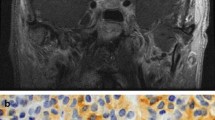Abstract
TSH-secreting adenomas are rare but must be considered in the differential diagnosis of inappropriately normal to elevated TSH in the presence of elevated free serum thyroid hormone levels (FT4, FT3), which is termed central hyperthyroidism. The diagnosis of TSH-secreting adenoma in a patient with central hyperthyroidism is usually made based on clinical and family history, α-subunit testing, SHBG levels, and pituitary MRI after ruling out other thyroid-related conditions as discussed in this chapter. A full pituitary hormone evaluation must be completed upon diagnosis of a TSH-secreting adenoma, and neuroophthomology evaluation should be obtained in the presence of a macroadenoma with concern for contact with the optic nerve or chiasm. Therapeutic options for patients with TSH-secreting adenomas include transsphenoidal pituitary surgery, medical treatment with somatostatin analogs (SSAs), radiation therapy, or a combination of these modalities. Regardless of treatment, these patients should have long-term endocrine follow-up with continued biochemical and radiologic surveillance.
Access this chapter
Tax calculation will be finalised at checkout
Purchases are for personal use only
Similar content being viewed by others
References
Beck-Peccoz P, Lania A, Beckers A, Chatterjee K, Wemeau JL. European thyroid association guidelines for the diagnosis and treatment of thyrotropin-secreting pituitary tumors. Eur Thyroid J. 2013;2:76–82.
Onnestam L, Berinder K, Burman P, et al. National incidence and prevalence of TSH-secreting pituitary adenomas in Sweden. J Clin Endocrinol Metab. 2013;98:626–35.
Amlashi FG, Tritos NA. Thyrotropin-secreting pituitary adenomas: epidemiology, diagnosis, and management. Endocrine. 2016;52:427–40.
Beck-Peccoz P, Persani L, Mannavola D, Campi I. Pituitary tumours: TSH-secreting adenomas. Best Pract Res Clin Endocrinol Metab. 2009;23:597–606.
Mindermann T, Wilson CB. Age-related and gender-related occurrence of pituitary adenomas. Clin Endocrinol. 1994;41:359–64.
Yamada S, Fukuhara N, Horiguchi K, et al. Clinicopathological characteristics and therapeutic outcomes in thyrotropin-secreting pituitary adenomas: a single-center study of 90 cases. J Neurosurg. 2014;121:1462–73.
Malchiodi E, Profka E, Ferrante E, et al. Thyrotropin-secreting pituitary adenomas: outcome of pituitary surgery and irradiation. J Clin Endocrinol Metab. 2014;99:2069–76.
Brown RL, Muzzafar T, Wollman R, Weiss RE. A pituitary carcinoma secreting TSH and prolactin: a non-secreting adenoma gone awry. Eur J Endocrinol. 2006;154:639–43.
Lee W, Cheung AS, Freilich R. TSH-secreting pituitary carcinoma with intrathecal drop metastases. Clin Endocrinol. 2012;76:604–6.
Nguyen HD, Galitz MS, Mai VQ, Clyde PW, Glister BC, Shakir MK. Management of coexisting thyrotropin/growth-hormone-secreting pituitary adenoma and papillary thyroid carcinoma: a therapeutic challenge. Thyroid. 2010;20:99–103.
Poggi M, Monti S, Pascucci C, Toscano V. A rare case of follicular thyroid carcinoma in a patient with thyrotropin-secreting pituitary adenoma. Am J Med Sci. 2009;337:462–5.
Brucker-Davis F, Oldfield EH, Skarulis MC, Doppman JL, Weintraub BD. Thyrotropin-secreting pituitary tumors: diagnostic criteria, thyroid hormone sensitivity, and treatment outcome in 25 patients followed at the National Institutes of Health. J Clin Endocrinol Metab. 1999;84:476–86.
Sanno N, Teramoto A, Osamura RY. Thyrotropin-secreting pituitary adenomas. Clinical and biological heterogeneity and current treatment. J Neuro-Oncol. 2001;54:179–86.
Socin HV, Chanson P, Delemer B, et al. The changing spectrum of TSH-secreting pituitary adenomas: diagnosis and management in 43 patients. Eur J Endocrinol. 2003;148:433–42.
Koulouri O, Moran C, Halsall D, Chatterjee K, Gurnell M. Pitfalls in the measurement and interpretation of thyroid function tests. Best Pract Res Clin Endocrinol Metab. 2013;27:745–62.
Beck-Peccoz P, Chatterjee VK. The variable clinical phenotype in thyroid hormone resistance syndrome. Thyroid. 1994;4:225–32.
Refetoff S, Weiss RE, Usala SJ. The syndromes of resistance to thyroid hormone. Endocr Rev. 1993;14:348–99.
Cartwright D, O'Shea P, Rajanayagam O, et al. Familial dysalbuminemic hyperthyroxinemia: a persistent diagnostic challenge. Clin Chem. 2009;55:1044–6.
Beck-Peccoz P, Brucker-Davis F, Persani L, Smallridge RC, Weintraub BD. Thyrotropin-secreting pituitary tumors. Endocr Rev. 1996;17:610–38.
Rapaport R, Akler G, Regelmann MO, Greig F. Time for thyrotropin releasing hormone to return to the United States of America. Thyroid. 2010;20:947–8.
Beck-Peccoz P, Persani L, Lania A. Thyrotropin-secreting pituitary adenomas. In: De Groot LJ, Chrousos G, Dungan K, et al., editors. Endotext. South Dartmouth, MA: MDText.com, Inc.; 2000.
Kirkman MA, Jaunmuktane Z, Brandner S, Khan AA, Powell M, Baldeweg SE. Active and silent thyroid-stimulating hormone-expressing pituitary adenomas: presenting symptoms, treatment, outcomes, and recurrence. World Neurosurg. 2014;82:1224–31.
van Varsseveld NC, Bisschop PH, Biermasz NR, Pereira AM, Fliers E, Drent ML. A long-term follow-up study of eighteen patients with thyrotrophin-secreting pituitary adenomas. Clin Endocrinol. 2014;80:395–402.
Beck-Peccoz P, Persani L. Medical management of thyrotropin-secreting pituitary adenomas. Pituitary. 2002;5:83–8.
Author information
Authors and Affiliations
Corresponding author
Editor information
Editors and Affiliations
Rights and permissions
Copyright information
© 2018 Springer International Publishing AG, part of Springer Nature
About this chapter
Cite this chapter
Dichtel, L.E. (2018). A Rare Entity: TSH-Secreting Adenoma. In: Nachtigall, L. (eds) Pituitary Tumors. Springer, Cham. https://doi.org/10.1007/978-3-319-90909-7_9
Download citation
DOI: https://doi.org/10.1007/978-3-319-90909-7_9
Published:
Publisher Name: Springer, Cham
Print ISBN: 978-3-319-90907-3
Online ISBN: 978-3-319-90909-7
eBook Packages: MedicineMedicine (R0)




